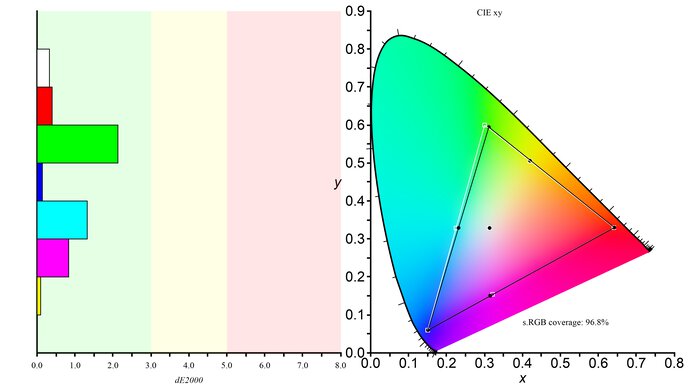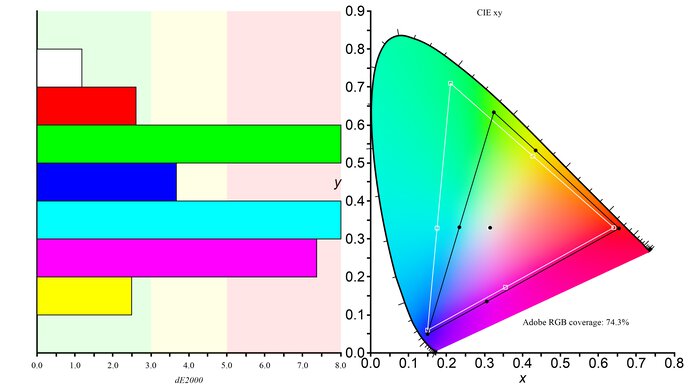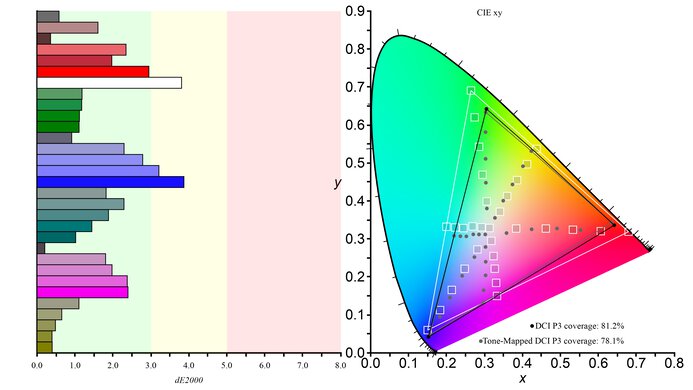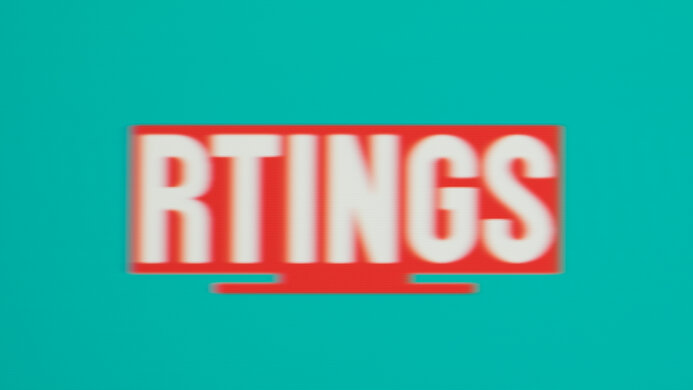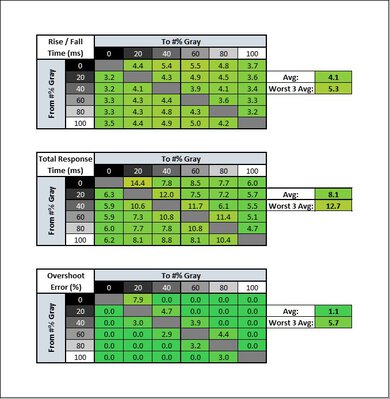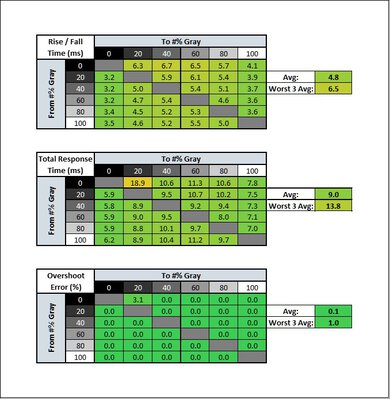The ASUS TUF Gaming VG259QM is an excellent IPS monitor that delivers a smooth and responsive gaming experience. It shares many similarities with its bigger brother, the ASUS VG279QM, as it also has a 1080p resolution and a 280Hz refresh rate. It has great visibility in bright environments thanks to its great peak brightness, but on the contrary, it isn't as well-suited for dark rooms due to its low contrast ratio. It has an excellent response time, a backlight strobing feature, as well as native FreeSync support, and G-SYNC compatibility. It supports HDR10; however, HDR content doesn't look significantly better than in SDR because it lacks a wide color gamut and local dimming. On the upside, it has a great build quality, wide viewing angles, and outstanding ergonomics.
Our Verdict
Overall, the ASUS TUF Gaming VG259QM is a good monitor. It provides a responsive and smooth gaming experience with its low input lag and high refresh rate. Its wide viewing angles and outstanding ergonomics make it easier to share work or content, and its great peak brightness makes it suitable for brightly-lit settings. Sadly, while it does support HDR, it can't display a wide color gamut and lacks local dimming.
- Wide viewing angles.
- Good reflection handling.
- Outstanding ergonomics.
- Low contrast ratio.
The ASUS TUF VG259QM is a good monitor for office use. The screen may be too small for some, especially for multitasking; however, it keeps the pixel density high, so text and images look sharper. It gets bright enough to overcome glare, and it handles reflections well. It has outstanding ergonomics and wide viewing angles, making it easy to share your work with coworkers.
- Wide viewing angles.
- Good reflection handling.
- Outstanding ergonomics.
- Screen size a bit small for multitasking.
The ASUS TUF Gaming VG259QM is a great gaming monitor. It has low input lag, and its motion handling is superb thanks to its fast response time, high refresh rate, and backlight strobing feature. It supports FreeSync natively and is compatible with NVIDIA's G-SYNC. Unfortunately, it has a low contrast ratio that makes it less ideal for gaming in the dark, and its compact size may be too small for some.
- High refresh rate.
- VRR support.
- Exceptionally fast response time.
- Outstanding ergonomics.
- Low contrast ratio.
The ASUS TUF Gaming VG259QM is a decent monitor for media consumption. It has a decent screen size with wide viewing angles so you can share content with others, and its outstanding ergonomics allow you to adjust the screen to your optimal viewing position with ease. It has great peak brightness and good reflection handling to combat glare in bright rooms, but its dark room performance isn't that great due to its low contrast ratio.
- Wide viewing angles.
- Outstanding ergonomics.
- Excellent gray uniformity.
- Low contrast ratio.
The ASUS TUF Gaming VG259QM is a good monitor for media creation. Its 24.5 inch screen provides a decent amount of space to work with, and its outstanding ergonomics allow you to position it however you like. It has near full coverage of the sRGB color space, but its coverage of Adobe RGB is much more limited. Unfortunately, it has a low contrast ratio, and it can't display a wide color gamut.
- Wide viewing angles.
- Outstanding ergonomics.
- Excellent gray uniformity.
- Low contrast ratio.
Unfortunately, the ASUS TUF VG259QM delivers a mediocre experience in HDR. It has a low contrast ratio and low peak brightness in HDR, so blacks look gray and washed out, and bright highlights don't stand out very well. It doesn't have a local dimming feature to improve contrast, and it can't display a wide color gamut. Overall, although it technically supports HDR, this adds almost nothing.
- Outstanding ergonomics.
- Fantastic gradient handling.
- Low HDR peak brightness.
- Low contrast ratio.
- Can't display a wide color gamut.
- No local dimming.
Changelog
- Updated Apr 14, 2023: Tested the monitor's compatibility with 1440p on the PS5, but it doesn't work.
- Updated May 02, 2022: We tested the monitor with the PS5's new variable refresh rate feature and confirmed that it's not compatible, since the PS5 only supports HDMI Forum VRR.
- Updated Apr 08, 2022: Updated to Test Bench 1.2, resulting in changes to the results and scores with the Response Time and Input Lag. Added tests for Console Compatibility and macOS compatibility and made minor changes to other tests, which you can see in our Changelog.
- Updated Aug 23, 2021: We redid the gradient test with a 10-bit signal.
Check Price
Differences Between Sizes And Variants
We tested the ASUS TUF Gaming VG259QM, which is also available in a 27 inch size. There are many monitors in the TUF Gaming lineup, some of which you can see in the table below.
| Model | Size | Panel Type | Resolution | Max Refresh Rate | Variable Refresh Rate |
|---|---|---|---|---|---|
| TUF Gaming VG259QM | 24.5" | IPS | 1920 x 1080 | 280Hz | FreeSync |
| TUF Gaming VG279QM | 27" | IPS | 1920 x 1080 | 280Hz | FreeSync |
| TUF Gaming VG27VQ | 27" | VA | 1920 x 1080 | 165Hz | FreeSync |
| TUF Gaming VG27AQ | 27" | IPS | 2560 x 1440 | 165Hz | FreeSync |
If someone comes across a different type of panel or if their ASUS TUF Gaming VG259QM doesn't correspond to our review, let us know, and we'll update the review. Note that some tests, such as gray uniformity, may vary between individual units.
Our unit of the ASUS VG259QM was manufactured in May 2020, and you can see the label here.
Popular Monitor Comparisons
The ASUS VG259QM is an excellent gaming monitor with fast response time and a high refresh rate; however, its smaller size isn't ideal for multitasking, and its HDR performance is limited due to the lack of a wide color gamut.
For more options, check out our other recommendations for the best gaming monitors, the best 1080p monitors, and the best budget gaming monitors.
The ASUS TUF Gaming VG259Qm is much better than the ASUS TUF Gaming VG249Q1A for gaming. It has a significantly higher refresh rate of 280Hz, resulting in smoother motion and better responsiveness. However, the VG259QM has slower response times and a higher input lag at 60Hz, so it's not as ideal for 60fps console gaming. That said, it's better suited for productivity than the VG249Q1A because it has a bigger screen, much better ergonomics, and provides better visibility in well-lit settings. It supports HDR, whereas the VG249Q1A doesn't, but it doesn't add much because it can't display a wide color gamut.
The ASUS TUF Gaming VG259QM and the ViewSonic XG2431 are both great gaming monitors. They both have similar motion handling, but the ViewSonic has a more versatile backlight strobing feature since you can adjust the pulse width and phase to your liking. The ViewSonic is also better for console gaming because it downscales a 4k image, which the ASUS can't do. Although both have 240Hz refresh rates, you can overclock the ASUS to 280Hz with a DisplayPort connection.
The ASUS TUF Gaming VG259QM is much better than the BenQ ZOWIE XL2546K. The ASUS has a better contrast ratio, higher peak brightness, and wider viewing angles. It has a stand with a much wider swivel range, and it supports HDR. The BenQ has better reflection handling, and its input lag is much lower when playing at 60Hz.
The ASUS TUF Gaming VG258QM is the TN variant of the ASUS TUF Gaming VG259QM. The TN panel, however, doesn't offer a significant advantage, as the VG259QM is a bit better in most ways that matter. They are very similarly built and look almost identical, but the IPS panel of the VG259QM has wider viewing angles and a slightly better contrast ratio. Most importantly, it has faster response times at both the max refresh rate and 60Hz, resulting in smoother motion. It also has a better HDR color gamut.

We buy and test more than 30 monitors each year, with units that we buy completely on our own, without any cherry-picked units or samples. We put a lot into each unbiased, straight-to-the-point review, and there's a whole process from purchasing to publishing, involving multiple teams and people. We do more than just use the monitor for a week; we use specialized and custom tools to measure various aspects with objective data-based results. We also consider multiple factors before making any recommendations, including the monitor's cost, its performance against the competition, and whether or not it's easy to find.
Test Results

The ASUS VG259QM looks almost identical to its bigger brother, the ASUS VG279QM, just in a smaller, more compact size. It has thin bezels on three sides and a slightly thicker bottom bezel. It isn't too flashy and won't look out of place in an office setting.
Outstanding ergonomics. It has a wide swivel range and can rotate to portrait mode in either direction. The back of the monitor is plastic and relatively plain. It can be VESA-mounted, but there's no quick-release feature. There's a small cutout at the bottom of the stand that serves as cable management.
The ASUS TUF VG259QM doesn't have a local dimming feature. The video above is provided for reference only.
Great SDR peak brightness. It's bright enough to combat glare in most lighting conditions and very consistent across different content.
These measurements are after calibration, using the 'Racing' Picture Mode and with Brightness set to maximum.
The HDR peak brightness is okay. The brightness is very consistent when displaying different scenes. It's not bright enough for bright highlights to stand out at all. It displays most scenes at the correct brightness, though, except for bright scenes, which are a bit too bright. There's also a very sharp cut-off at the monitor's peak brightness, which causes a loss of fine details in bright scenes.
These measurements are before calibration, using the 'ASUS Gaming HDR' Picture Mode. The screen's brightness is locked in this picture mode.
Like most IPS panels, the ASUS VG259QM has a good horizontal viewing angle, but it isn't as good as the ASUS VG279QM. Colors appear washed out when you reach moderate viewing angles, and brightness decreases as well.
The vertical viewing angle is okay. The top and bottom of the screen remain accurate even if you sit up close due to the smaller screen size. It's more important if you have a multi-monitor setup where it's mounted above eye level.
Before calibration, the ASUS VG259QM has good color accuracy. It has an sRGB mode that's more accurate than the other picture modes, but using it locks most picture settings. It's not very effective at limiting colors to the sRGB color space, but the other picture modes are more over-saturated. There are some minor inaccuracies with a few colors, and white balance is a bit off. Gamma is close to the sRGB target curve, but dark scenes are a bit too dark and bright scenes are slightly brighter than they should be. The color temperature is quite cold, giving everything a slightly bluish tint.
After calibration, color accuracy is superb. Any remaining color inaccuracies shouldn't be visible to the naked eye. White balance and gamma are nearly perfect. The color temperature is no longer cool and is nearly perfect.
The ASUS VG259QM has an excellent SDR color gamut. It has near-full coverage of the commonly-used sRGB color space, but its coverage of the Adobe RGB color space is mediocre. If you want a gaming monitor with an even wider SDR color gamut, check out the ASUS ROG Strix XG27AQ.
The ASUS TUF VG259QM's reflection handling is good. The matte anti-reflective coating does a great job of reducing the intensity of direct reflections but doesn't do as well when it comes to bright ambient lighting.
The ASUS TUF Gaming VG259QM has outstanding gradient handling. At the max refresh rate it only supports an 8-bit signal, and there's some banding in darker shades. If you decrease the refresh rate to anything below about 237Hz, it can also accept a 10-bit signal, and there's barely any banding in any shade.
The ASUS VG259QM's native 240Hz refresh rate can be overclocked to 280Hz using the OSD menu setting called 'Overclock,' but only over a DisplayPort connection.
The ASUS TUF VG259QM supports FreeSync variable refresh rate technology, and it's compatible with NVIDIA's G-SYNC Compatible mode which only works over a DisplayPort connection.
| Overdrive Setting | Response Time Chart | Response Time Tables | Motion Blur Photo |
| 0 | Chart | Table | Photo |
| 20 | Chart | Table | Photo |
| 40 | Chart | Table | Photo |
| 60 | Chart | Table | Photo |
| 80 | Chart | Table | Photo |
| 100 | Chart | Table | Photo |
| 120 | Chart | Table | Photo |
The ASUS VG259QM has an excellent response time when playing at the maximum refresh rate of 280Hz, resulting in minimal motion blur in fast-moving scenes. Like most monitors, there are many overdrive settings available to customize your gaming experience. We recommend using the '120' overdrive mode, as it provides the best performance with virtually no overshoot. This mode is actually a hidden setting that has to be enabled through the service menu (find out how here). If you don't want to use this hidden mode, the '60' mode is almost as good, but it has a slower rise/fall time, so there's a longer blur trail behind fast-moving objects.
| Overdrive Setting | Response Time Chart | Response Time Tables | Motion Blur Photo |
| 0 | Chart | Table | Photo |
| 20 | Chart | Table | Photo |
| 40 | Chart | Table | Photo |
| 60 | Chart | Table | Photo |
| 80 | Chart | Table | Photo |
| 100 | Chart | Table | Photo |
| 120 | Chart | Table | Photo |
This monitor has an excellent response time when gaming at 120Hz from a PS5 or Xbox Series X. Again, the level of overdrive can be customized, but unlike at the max refresh rate, the '40' setting delivers the best experience overall at 120Hz. If you're looking for a "set-and-forget" mode that works well at both 120Hz and 280Hz, the '60' setting is your best choice, but it has a bit more inverse ghosting at 120Hz than at the max refresh rate, and it's not a very good choice for 60Hz gaming.
| Overdrive Setting | Response Time Chart | Response Time Tables | Motion Blur Photo |
| 0 | Chart | Table | Photo |
| 20 | Chart | Table | Photo |
| 40 | Chart | Table | Photo |
| 60 | Chart | Table | Photo |
| 80 | Chart | Table | Photo |
| 100 | Chart | Table | Photo |
| 120 | Chart | Table | Photo |
The response time at 60Hz is great. The best overdrive setting is '20,' as higher settings have way too much overshoot. Like at the max refresh rate, the '120' setting is a hidden mode that has to be enabled in the service menu. Although it's the best mode at 280Hz, it's terrible at 60Hz, with terrible overshoot that makes it unusable for gaming. Unfortunately, this means you'll likely have to go into the monitor's menus and change your overdrive setting each time you switch to 60Hz, as there's no single mode that performs well at any refresh rate.
| Refresh Rate | VRR Status | Motion Blur Photo |
| 280Hz | Off | Photo |
| On | Photo | |
| 120Hz | Off | Photo |
| On | Photo |
The ASUS TUF Gaming VG259QM has an optional backlight strobing feature, commonly known as black frame insertion, to help improve motion clarity. Unlike most monitors, the amplitude of each pulse can be adjusted, as the backlight setting isn't locked when ELMB is enabled. The standard ELMB setting (without VRR) works between 120Hz and 280Hz, while the ELMB Sync setting (with VRR) can be enabled between 50Hz and 280Hz, but it doesn't actually do anything between 50Hz and 85Hz.
The ASUS VG259QM has exceptionally low input lag, even with VRR enabled. However, it rises significantly when playing at 60Hz, making it less suitable for console gaming.
The ASUS VG259QM has a decent resolution and size. The screen may be a bit small for multitasking since there's less room to have multiple windows opened side-by-side, but it's a good size for a 1080p display, as it makes the pixel density higher.
The ASUS TUF Gaming VG259QM only supports basic 1080p formats from the PS5. It supports HDR, but can't downscale a 4k image. If you want something that can downscale a 4k signal, then check out the ViewSonic XG2431.
Unfortunately, this monitor has very limited compatibility with the Xbox Series S|X. VRR works, but if you disable VRR from the monitor's menus, you'll have to turn the monitor off and on again to reenable it. This is only an issue with the Xbox. It can't downscale a 4k image, which means that HDR doesn't work either, since the Xbox only supports HDR with 4k signals. 1080p @ 120Hz works, but you have to override the resolution and refresh rate on the Xbox.
The USB input is a service port and can only be used for firmware updates.
The ASUS TUF VG259QM doesn't quite work properly with recent Macs. The 280Hz overclock feature doesn't work at all, so you're limited to 240Hz. VRR works, but if you toggle it off and on while connected to a Mac, it sends the monitor into power save mode. There are also some intermittent issues with sleep mode, as windows wouldn't always return to their original position when closing the lid on an M1 MacBook Pro.
The ASUS VG259QM has many extra features, including:
- Crosshair: Puts a virtual crosshair for shooter games.
- Timer: Puts a timer on the screen.
- FPS counter: Overlay that shows the current frame rate.
- Display alignment: Helps align monitors in a multi-monitor setup.
- Zoom: Zooms in to enlarge a section of the image.
- Shadow Boost: Helps make objects more visible in dark scenes.
- Blue light filter: Helps reduce eye strain.


























